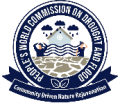
The People’s World Commission on Drought and Flood:
The People’s World Commission on Drought and Flood (PWCDF) was established on the occasion of World Water Week in Stockholm, Sweden. Under the Chairmanship of Stockholm Water Awardee and Magsaysay winner, Dr Rajendra Singh, popularly known as the Waterman of India, the goal is to reduce risks to lives, livelihoods, and ecosystems by building community resilience to extreme weather events such as droughts and floods through community-driven nature rejuvenation.
The Secretariat of the PWCDF is at the Institute of Advanced Materials (IAAM). The IAAM is a renowned non-profit international scientific research organization active in the world of advanced materials. The organization works to facilitate a highly interactive community of advanced materials researchers and to stimulate partnerships, collaborations, and joint ventures that can translate into the rapid development of the scientific world. With the motto of ‘Advancement of materials to global excellence’, IAAM strives to utilize the sector of advanced materials to find solutions to the pressing issues of the world.
To more know about Dr Rajendra Singh, visit this page.
Mission
Reducing climate risks of droughts and floods and building resilient communities and economies through community-centered nature rejuvenation.
Goal
To bridge the gaps between policy, science, knowledge, and community action by bringing together communities, scientists, engineers, technocrats, environmentalists, ecologists, social activists, hydrologists, youth and other stakeholders to reduce impact of droughts and floods and build resilience at ground level.

Objectives
- Prepare an annual report that provides a summary of the state of floods and droughts in various parts of the world by capturing perspectives through people’s dialogues and community engagement, as well as discussions with technocrats, scientists, ecologists, environmentalists, agriculturists, and decision makers, among other people;
- Explore, evaluate, and document the various community-centered decentralized human actions that led to nature rejuvenation and resulted in climate resilience;
- Utilize the information obtained from the community to persuade the state to invest in measures to make communities more resilient to the effects of drought and flood;
- Encourage students to adopt more environmentally conscious and mindful behaviors by leveraging the educational system.
- Wherever the demand, create awareness, and train local stakeholders for facilitating ecologically and financially sound, equitable and culturally appropriate community driven nature rejuvenation.
Background
The area affected, the number of occurrences, and the severity of droughts and floods have all grown significantly over the course of the last few decades. These extreme weather events have been attributed to a variety of causes, including natural phenomena, deforestation, disruptions in river flows and drainage, drying up of life-saving rivers, encroachment of riverbeds and other surface water bodies, excessive extraction of groundwater, and most recently, climate change. Natural ecosystems that protected against catastrophic weather events and provided a buffer against their effects are being destroyed. The disruption of the monsoon cycle, the increase in cloudbursts, and the accelerated melting of glaciers have all been attributed to climate change. Rain, the primary source of water that helped nourish the planet in now often the cause of drought and flood due to human interventions.
These crises are now a global phenomenon that are leading to displacement and forced migration: the poor, the disadvantaged, women, children, and youth are being forced to move away from their roots and to relocate to urban areas and other countries in order to survive. This has resulted in a rise in poverty and inequality, as well as an environment that is increasingly unstable and ripe for potential conflict. The people who are affected by natural disasters like floods and droughts are not always to blame for their plight.
Traditional knowledge that once existed all over the world and assisted communities in coping with these events has been lost, and there is a pressing need to investigate, conduct research on, and encourage the use of traditional coping mechanisms and resilience. In India, for instance, groundwater recharge brought about by rainwater harvesting has resulted in a revival of the agricultural economy and even the revival of dead rivers like the Sherni in the state of Rajasthan. This community-driven and decentralized nature rejuvenation work, which was facilitated by Tarun Bharat Sangh, was carried out in extremely challenging environments, which reassures us that this kind of work is possible in a variety of locations across the world.
To meet its objectives, the PWCDF will undertake the following:

1. Collate, research and document an Annual Report of People’s perspectives on drought and floods:
The PWCDF gather information on how people are affected by flood and drought, how they are coping, and how resilience can be built into society. They will do this so that they can better understand how resilience can be built into society. The scientific and technical groups will be responsible for supplying both the information and the research inputs. This yearly report will be based on information collected from different parts of the world in terms of how people are affected, the causes behind the disasters, the methods of coping, traditional practices that are used, and how communities have become more resilient through efforts to rejuvenate nature. This captured klnolwedge will be then disseminated widely for influencing policy and action.
This report is essential to the PWCDF because it will reflect the realities on the ground and also provide a set of community-driven resilience initiatives that are both practical and have been demonstrated to be effective in order to leverage action from the state and other stakeholders.
2. Facilitate and enable the implementation of drought and flood resilience in various geographical areas:
Wherever possible, facilitate the implementation of nature rejuvenation work in diverse geographical areas based on the recommendations of the Annual Report of People’s Perspectives on Drought and Floods. This can be done by raising awareness, engaging in dialogue, and providing support for planning and decision making.
3. Dialogue and engagement with the State:
By engaging and influencing the state for action towards developing community resilience. This engagement will be through seminars, workshops, exposure visits, and other means, to create a climate conducive to knowledge-based, community-centered drought and flood resilience.
4. Establishing departments of behavioral change in educational institutions such as universities:
These departments will concentrate on changing the behaviors of young people in order to bring about the realization, internalization, and implementation of ecosystem-based and specific adaptation measures and economic models in order to build up a person’s resistance to drought and flood. These departments will also investigate potential models of social and economic growth that are in harmony with nature, can be maintained for the long term, promote equity, and ultimately result in peace and safety.
5. The testing of models for the development of sustainable watersheds:
These models are essential for lowering the rates of soil erosion and siltation. These models will be tested in specific river basins that are prone to drought and flooding in a few countries around the world that have been identified.
